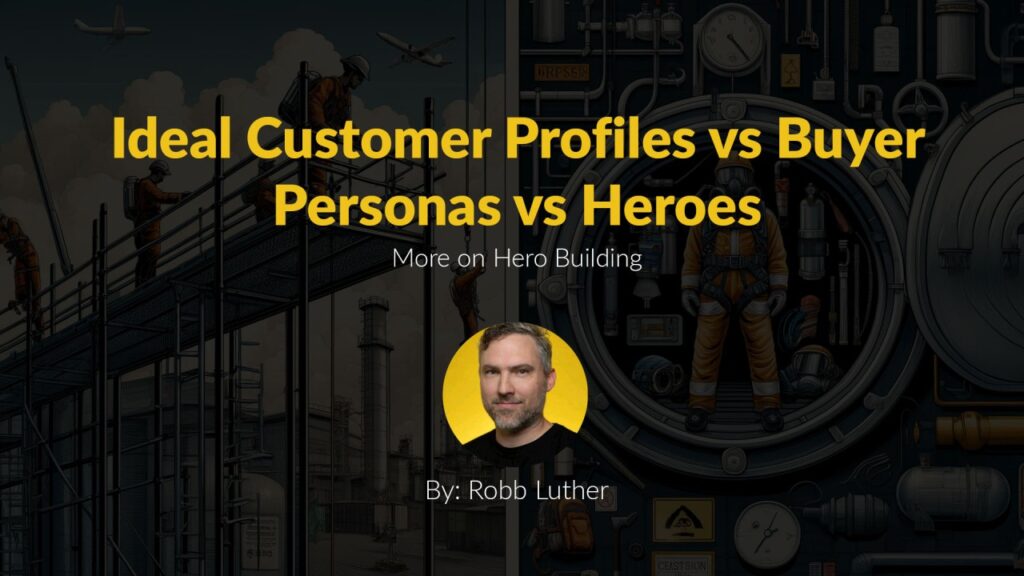I have a habit of using the ideal customer profile and buyer persona interchangeably, but they are different. Also, Heroes and Buyer Personas are distinct. Let’s dig in.
Ideal Customer Profiles (ICPs)
An Ideal Customer Profile is a detailed description of the type of company that would benefit most from your product or service. It typically includes firmographic data such as company size, industry, location, and other characteristics that make a company a perfect fit for what you offer.
At PIC, our ideal customer profiles are B2B Businesses in the occupational health and safety industry with revenue in the $5 million to $50 million range located in North America.
When developing your ideal customer profile, consider the industry, industry sectors/subsectors, and delivery models.
For example, we love OHS, but there are a variety of sectors and subsectors. We work a lot with Work-at-Height Safety. Work-at-Height can be a Construction Safety, Fire Rescue, and Arbor Safety subsector. Looking at these three dramatically different industries, you can imagine how you may speak differently to each one.
Our OHS companies are trying to keep people safe. Safety delivery methods could include SaaS applications for safety observations, training, consulting, or deployment of safety team. Again, looking at these delivery methods, you can see various ways you may want to communicate your products and services to decision-makers.
Defining your ICPs allows you to really focus on a personalized user experience by aligning your products, services, and messaging to the very specific challenges your hero faces.
Buyer Personas
Buyer Personas are the semi-fictional representations of your ideal customers based on market research and real data about your existing customers. They focus on individual decision-makers or users within the target companies identified in your ICP.
Buyer Personas give you a sense of who you will be addressing within the market and a sense of the potential reach of your sales and marketing efforts.
Companies build buyer personas as a targeting tool. To me they always felt a bit predatory and do not come with the perspective shift of looking at outcomes through the eyes of your customer.
Heroes
There are two key differences between your Heroes and Buyer Personas: Alignment and Perspective.
Alignment to Core Values
Heroes represent the best of your customers. They are the prospects and customers who not only fit the profile of your ideal buyer but also fall into alignment with your core values. These are your great customers, the ones who derive the most value from your offerings and, in turn, contribute significantly to your business.
Perspective Shift
When you develop Heroes, you develop a relationship with your best customers and look at their desired outcomes from their perspective. Work to shift your perspective from what you can provide them to what your Hero needs to be successful.m
When you understand the desired outcomes of your Heroes, you can build robust Mission Strategies around those outcomes to build a full picture of their journey. From here, you can begin to align your products and services, along with your expertise, and inject as much value as you can into their journey, guiding them to success.
By ensuring that Heroes match both your Ideal Customer Profiles and core values, the Hero Mission strategy will build relationships with the customers who are most likely to succeed with your offerings and who will become enthusiastic advocates for your brand. This approach leads to more meaningful and sustainable business growth, as it prioritizes value-driven connections and long-term loyalty.
Conclusion
While Ideal Customer Profiles and Buyer Personas offer valuable insights into the types of companies and individual decision-makers to target, the Hero provides a deeper, value-driven perspective. Heroes are not just about fitting a profile or persona; they align with your core values and share a mutual vision for success.
By focusing on Heroes, you create a relationship-centered approach that prioritizes the desired outcomes of your best customers. This doesn’t mean ignoring other potential buyers. On the contrary, by speaking to your Heroes through your marketing, you’re setting a standard and tone that others will hear as well. This approach can inspire other buyers to align more closely with the qualities of your Heroes.
Heroes are your best-fit customers because they embody the alignment of needs, values, and aspirations that lead to mutual success. Whether they seek the best value, the fastest service, or the most innovative solutions, understanding and addressing their specific outcomes ensures your marketing resonates deeply with them. This focus builds a loyal customer base that advocates for your brand and drives sustainable business growth.
Developing Heroes is crucial because you want to engage them through your marketing and sales efforts. By aligning your strategy with the values and needs of your Heroes, you develop stronger, value-driven connections. This approach enhances customer satisfaction and loyalty, ensuring your business grows through authentic and meaningful relationships.

